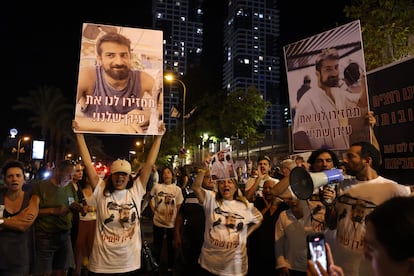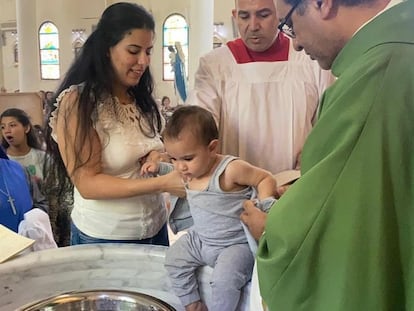The dilemma of the families of hostages in Gaza: ‘My heart tells me one thing; my mind, another’
Civil society groups are organizing vigils, murals and banners for the more than 200 people kidnapped in the enclave, while Israel decides whether to negotiate their release or try to rescue them

“It’s the million dollar question. And I don’t have an answer. My heart tells me that it is better for the troops not to enter, but my mind tells me that Hamas must be destroyed. Each option is worse than the other. And I just want to see my sister again.” Shaule Naor is 73 years old and carrying posters with faces of his relatives who were kidnapped on October 7, when Hamas launched a surprise attack in Israeli territory.
Naor’s sister, who is five years younger him, is Efrat Katz. She was formally declared a hostage on Thursday, after several days of verification, as were his grandchildren Raz, four years old, and Aviv, two years old. The three appear briefly in a video — recorded with a cell phone by one of the kidnappers — where they are seen while a militants shouts “God is the greatest” and covers the head of the children’s mother, Doron Asher Katz. The three are among the 210 hostages captured by Gaza militias — according to data updated on Saturday by the Israeli army — to demand the release of all Palestinians in prison in Israel. Doron is on the list of missing people, which includes around 100 names. Around 1,400 Israelis have been killed.
The “million dollar question” that Naor mentions is the one that Israeli political and military leaders are asking themselves as they prepare a ground invasion of Gaza. Is it better to invade and bomb Gaza to achieve the stated goal of “eliminating Hamas” when this will likely sentence the hostages to death? Or to come up with risky rescue operations, with little chance of success, in the underground tunnels where they are presumed to be held captive? Or is it better to negotiate the hostages’ release, as Israel has done for decades, even if its enermies perceive this as weakness and organize more kidnappings?
For Naor, an Israeli-American who was visiting his family, it’s not clear what the right answer is. “If you are rational, you know that the chances of them getting out alive without negotiation are very low. On the other hand, almost two weeks have passed and I don’t know if they have been able to survive in those conditions, especially the children,” he responds. The Islamic Jihad has also claimed, without presenting evidence, that the bombings have already killed around 20 of the hostages.
Naor is speaking in front of an installation of around 150 images of the missing and kidnapped people. The display has been put up in front of Kirya, the military base that houses the Ministry of Defense, in the heart of Tel Aviv. This is where key decisions are made about the three-phase plan with which Israel intends to overthrow the Hamas government, put an end to the foreseeable strongholds of resistance and hand over the keys to the management of Gaza, although it is not clear to whom. Soldiers leaving the base and passers-by stop, and moved by the display, and write messages on the mural, such as “Bringing you home is our top priority,” “First of all and at any cost,” and “Victory is the return of the hostages.” The movement’s motto is written in English on a huge canvas on an esplanade: “Bring them home now.” The question is how.
“We are calling for the immediate release of all hostages without conditions. And we are asking all parties for it. We are a movement with a single issue on the agenda,” explains Daniel Shek, one of the 15 so-called ambassadors of the Hostages and Missing Families Forum, the main organization hastily assembled to represent the victim’s families, offer them psychological support, draw attention to their cases and put pressure on the government. The movement’s goal is to make sure decision-makers do not forget about them. Last week alone, a vigil was held every day, drawing hundreds of participants in Tel Aviv. There was also a Sabbath dinner with as many empty chairs as hostages in Gaza, which connects with the Jewish tradition of leaving an empty cup for the prophet Elijah, who will signal the arrival of the Messiah.

The ambassadors are former diplomats, so Shek measures his words. “We are not going to go into how to achieve their release. It is neither our role nor our responsibility to say so. Nor are we the Israeli government, which takes into account other interests and considerations.” He adds: “We have zero ability to decide what is going to be done.”
Shek explains that the families of the kidnapped and missing also have different opinions on what should happen. One has called for the state to agree to a prisoner exchange, while another has said that he was pleased to know that his relative was killed because it ended the uncertainty.
The Hostages and Missing Families Forum has spoken out against the government for allowing humanitarian aid to enter southern Gaza from Egypt. “We are not against the fact that it was done, but rather that it was done without anything in exchange,” argues Shek. Israel, which is blocking the supply of food, water, fuel and electricity into Gaza, had said not a single ton of aide would enter Gaza while there were still hostages.
More than 230 kidnapped
Last Tuesday, Hamas put the number of hostages at at least 200. On top of this, another 30 Israelis were kidnapped by Islamic Jihad and an undetermined number are in the hands of other small groups and even people who are not active in armed organizations. Most are alive, although bodies were also brought to Gaza, as Israel in the past has agreed to release prisoners in exchange for the return of their dead.
Most of the hostages are civilians, who were captured at an open-air rave party that turned into a massacre (about 260 dead), in their homes, trying to flee or fighting in the streets of around 20 towns. The Israeli army estimates that around 30 children under the age of 18 were kidnapped and between 10 and 20 hostages are over 60. The ages range from a six-months-old baby to an octogenarian couple. The spokesman for Islamic Jihad, Dawood Shihab, said Israel keeps Palestinian women and children imprisoned, so they too did not “take into account” the age or gender of the hostages. Hamas has released propaganda videos of militants holding a baby in one hand and a rifle in the other.

Dafna Serr, 53, is a psychologist and goes to the mural with the Israeli country’s flag. “I am bringing it because they have attacked us for being that, Israelis,” she says. It is the same one that she took every Saturday to the demonstrations against Benjamin Netanyahu’s judicial reform. Serr is part of No Mental Health Without Democracy, group of health workers who took a stand against the reform that would have taken away powers from the Supreme Court. But with Israel now at war against Hamas, the group is focusing on helping the families of victims, hostages and missing people. She is working with four families of kidnapped people and argues that their desire to be reunited with their loved ones takes precedence over any political considerations.
“They are not in denial. In fact, some were chatting with them when they were captured. The thing is that all they want is for them to be returned home. And that has a lot to do with the most basic human feelings than with anything political or national about how to achieve it,” she says. Serr also laments the “mirage of control” that families get from spending hours in front of the television or cell phone waiting for the slightest clue. “It only deepens the trauma,” she laments.
Two phrases are often heard in Israel now: “We will overcome” and “revenge.” The last one was used by Israeli Prime Minister Benjamin Netanyahu and by Tally Gotlib, a deputy from his Likud party, when calling for an atomic bomb to be dropped on Gaza, where 4,385 Palestinians, most children and women, have already died in the bombings, according to figures from the Gaza Strip’s Ministry of Health.
Tal (he does not want to give his last name) does not even want to hear those words as he cries standing in front of the photo of his nephew Omer Shem Tov, 21, on the mural. “I don’t want revenge. I just want him back. And for those other people, who have done nothing to anyone, to be returned. And I don’t care about the price.”
The price asked by the Gaza militias is for Israel to release all Palestinians (about 5,200) who are serving sentences for so-called “nationalist crimes” in Israel. That is, those linked to the conflict, from a lethal attack to throwing stones at settlers or soldiers or supporting on social media a group considered to be a terrorist organization.
Over the decades, Israel has freed thousands of prisoners in exchanges. Just 12 years ago, for example, it freed more than 1,000 Palestinians for a single soldier, Gilad Shalit, who Hamas was holding in Gaza. This time, however, Israel insists that there is no room for negotiation. “This is in fact a moral question – are we prepared to abandon these people? I am not taking lightly the blow we have suffered and the need to respond very powerfully and restore Israel’s deterrent power,” David Meidan, a Mossad veteran who took part in the negotiation for Shalit, argued in the newspaper Haaretz. On the opposite ideological side, commentator Nadav Haetzni warned in the newspaper Israel Hayom: “There is a fine line between showing empathy and promoting national weakness. And we should not cross it.”
Confidential rescue plans
Military correspondents speak of confidential plans to rescue the hostages after gathering intelligence about their whereabouts and physical condition. The high-tech sector is developing special algorithms and facial recognition mechanisms for the mission.
As is often the case, what is announced is one thing and what is known is another. Some of the public information is aimed at giving false leads to Hamas, which has people who speak Hebrew and follow the news. Meanwhile, the families of the hostages are privately given the data obtained from surveillance systems, spies on the ground, security cameras and the videos recorded by both the assailants and the victims.
In the negotiations mediated by Qatar, the hostages have been divided into three groups. One contains Israeli soldiers and police, whose release Hamas completely refuses. The second group contains Israeli civilians, like Maya Shem, the young woman who appears in a video released last Tuesday, in the first proof of life provided by Hamas. She also has French nationality.
And the third group contains the foreigners, who are most likely to be saved, as evidenced by the fact that U.S. citizens Judith Raanan, 59, and her daughter Natalie, 17, were the first to be released on Friday, apparently in good health. They are the “guests”, who will be released without conditions “as soon as the situation permits,” with the exception of those who served in the Armed Forces, as stated by Abu Obaida, the spokesman for the Izz ad-Din al-Qassam Brigades, the armed wing of Hamas, which is holding the vast majority of hostages.
Sign up for our weekly newsletter to get more English-language news coverage from EL PAÍS USA Edition
Tu suscripción se está usando en otro dispositivo
¿Quieres añadir otro usuario a tu suscripción?
Si continúas leyendo en este dispositivo, no se podrá leer en el otro.
FlechaTu suscripción se está usando en otro dispositivo y solo puedes acceder a EL PAÍS desde un dispositivo a la vez.
Si quieres compartir tu cuenta, cambia tu suscripción a la modalidad Premium, así podrás añadir otro usuario. Cada uno accederá con su propia cuenta de email, lo que os permitirá personalizar vuestra experiencia en EL PAÍS.
¿Tienes una suscripción de empresa? Accede aquí para contratar más cuentas.
En el caso de no saber quién está usando tu cuenta, te recomendamos cambiar tu contraseña aquí.
Si decides continuar compartiendo tu cuenta, este mensaje se mostrará en tu dispositivo y en el de la otra persona que está usando tu cuenta de forma indefinida, afectando a tu experiencia de lectura. Puedes consultar aquí los términos y condiciones de la suscripción digital.
More information
Archived In
Últimas noticias
Welcome to the post-religion era: The idea of Christianity as the absolute truth has become obsolete
‘I thought you would like it’: The risky sexual practice popularized by TV shows and TikTok
The digitalization of tourism: ‘They promise experiences and gave us the worst possible one’
Mexican peso defies uncertainty with forecasts of a new period of stability in 2026
Most viewed
- Sinaloa Cartel war is taking its toll on Los Chapitos
- Reinhard Genzel, Nobel laureate in physics: ‘One-minute videos will never give you the truth’
- Oona Chaplin: ‘I told James Cameron that I was living in a treehouse and starting a permaculture project with a friend’
- Why the price of coffee has skyrocketed: from Brazilian plantations to specialty coffee houses
- Silver prices are going crazy: This is what’s fueling the rally











































